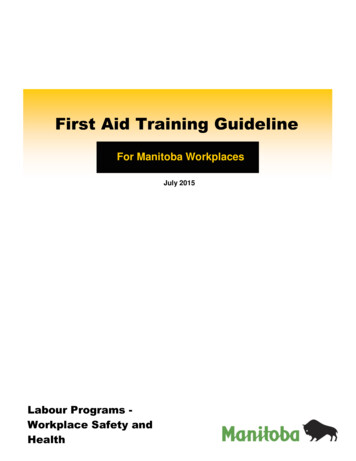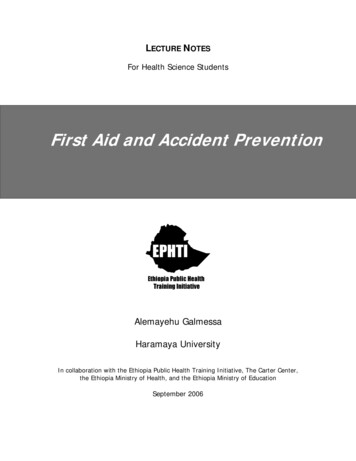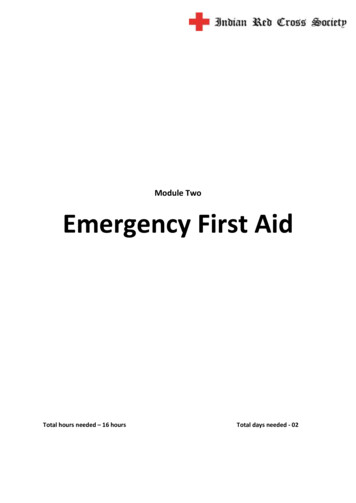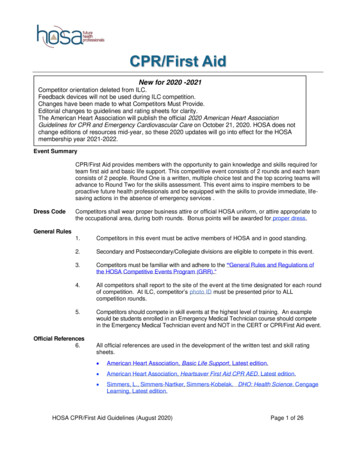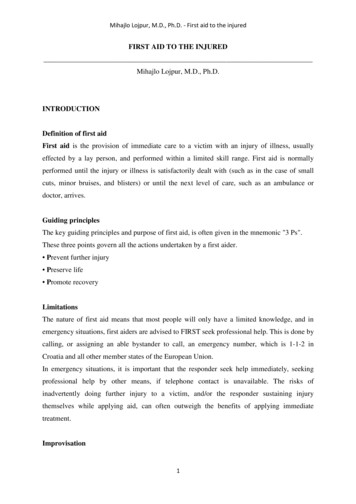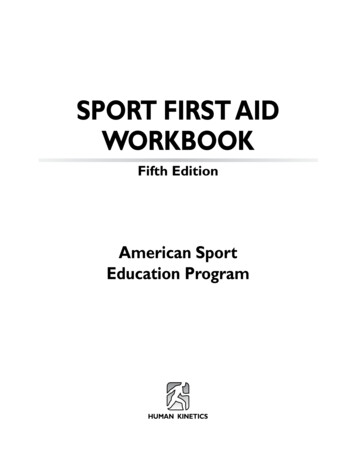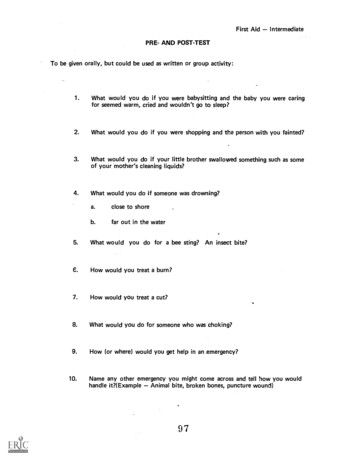
Transcription
First AidIntermediatePRE- AND POST-TESTTo be given orally, but could be used as written or group activity:1.What would you do if you were babysitting and the baby you were caringfor seemed warm, cried and wouldn't go to sleep?2.What would you do if you were shopping and the person with you fainted?3.What would you do if your little brother swallowed something such as someof your mother's cleaning liquids?4.What would you do if someone was drowning?a.close to shoreb.far out in the water5.What would you do for a bee sting? An insect bite?6.How would you treat a burn?7.How would you treat a cut?8.What would you do for someone who was choking?9.How (or where) would you get help in an .emergency?10.Name any other emergency you might come across and tell how you wouldhandle it?(ExampleAnimal bite, broken bones, puncture wound)97
First AidIntermediateFIRST AID SEARCHPR ES S UR EP 01 NT OBZOR0INT ME NT E OR DI NORMA LINLMSC OM P OUN DE EO0TNNNUAULSISPRRSSEEIEZT0ILAELIIUARIRLEKTPSS NOSICEPANIHSC INFECTION LQ0 IST HT UCNNC S DB SE LGAC BE T HT OR T ADT SUN AT E T FJRTAHIIIMATCNB AR AR TY AGE RM ICR CI TP URE POINTRABIESSALTSHOCKSIMPLE RNIQUETLESION98SN AO EMATCHNORMALOINTMENTSPUNTAALDAL DRESSINGEMETICGAUGETT
First AidIntermediateRESOURCESFILMSNote:Please be polite and follow the directions. If people abuse the privilege, these freefilms will be made unavailable.The following films are from The Educator's Guide to Free Films. It is asked that youfollow this procedure when ordering films:1.2.3.4.Requests should be made on official stationery.Requests should be made by teachers, not students.Requests should mention The Educator's Guide to Free Films.Requests should be made well in advance. Two alternate dates should also begiven.5.Requests are to be made to the address givrn.Breath of LifeMouth-to-mouth resuscitation, 16mm, 16 minutes, sound. American Heartobtain from local or state Heart Association. Borrower paysAssociationtransportation charges. Book three weeks ahead.Cardiopulmonary Resuscitation, Recent Developments and Emergency Care16mm, 20 minutes, sound. Ayerst Laboratories, Mr. Robert Clough, Jr.,Director of Audiovisual Services, 685 Third Avenue, New York, New York10017. Borrower pays no postage. Book 8 weeks ahead. Return after threedays by U. S. mail.Chance to Save a LifeMouth-to-mouth resuscitation, 16mm, 14 minutes, sound. Americar Heartobtain from local or state Heart Association. Borrower paysAssociationtransportation charges. Book 3 weeks ahead.Child Safety Is No Accident16 mm, 13 minutes, sound (available only to 7th grade and above), ModernTalking Picture Service, 1145 North McCadden Place, Los Angeles, California90038. Borrower pays only return postage. Book at least 1 month ahead.In Time to LiveGeneral life support techniques, 16mm, 18 minutes, sound. American Heartobtain from local or state Heart Association. Borrowgr paysAssociationtranportation charges. Book 3 weeks ahead.Life on the LineEmergency care systems, 16mm, 20 minutes. American Heart Association,obtain from local or state Heart Association. Borrower pays transportationcharges. Book 3 weeks ahead.99
First AidIntermediateStandard First Aid Series16mm, 270 minutes, sound. This is a series of 10 films, 27 minutes each.American National Red Cross. Most can be obtained from the local FledCross Chapter. If not, contact: General Supply Office, American NationalRed Cross, 18th and "E" Streets, N.W., Washington, D.C. 20006. Borrowerpays return postage. Book 2 months in advance.That They May Live16mm, 24 minutes, sound. Artificial respiration. Amalgamated Meat Cuttersand Butchers, Workmen of North America, Department of Education, 2800North Sheridan Road, Chicago, Illinois 60657. Pay return postage (U.S.MailSpecial Handling). Book 6 weeks ahead and give alternate date:--For the following films, mention Elementary Teachers' Guide to Free Curriculum Materialsand use school.stationery.Mountain and Desert SurvivalDesert Survival (TF 5571b). 16mm, 31 minutes, sound. Department of theAir Force, Air Force Central Audio Visual Library, Aerospace AudiovisualService, Norton Air Force Base, California 92409. Postage is paid by theDepartment of the Air Force. Book 3 weeks in advance.Mouth-to-Mouth Resuscitation(TV 495) 16mm, 28 minutes, sound. Department of the Army, FortMacArthur, California 90731. Borrower pays transportation charges one way.Book well in advance. Must be ordered with special forms.Mouth-to-Mouth Resuscitation in J.H.S.(10566) 16mm, 16 minutes, sound. Ayerst Laboratories, Mr. Robert T.Clough, Jr., Director of Audiovisual Services, 685 Third Avenue, New York,New York 10017. Borrower pays no postage charges. Book 8 weeks inadvance. Return 3 days after receipt.Techniques of Exhaled-Air Artificial Respiration(FTA 458), 16mm, 11% minutes, sound. Department of the Air Force, AirForce Central Audio Visual Library, Aerospace Audiovisual Service, NortonAir Force Base, California 92409.When Seconds Count16mm, 4 minutes, sound. American National Red Cross, your local RedCross Chapter or General Supply Office, American National Red Cross, 18thand "E" Streets, N.W., Washington, D.C. 20006. Borrower pays returnpostage. Book 2 months in advance.100
First AidIntermediateDysart Film Library, 977-7281, Ext. 45. Use special order forms.The Life You Save, 5450, 17 minutes.How to Save a Choking Victim, 320, 11 minutes.FilmstripsDysart Media CenterSafety on the StreetsLiving in the Machine AgeSafety in the HomeSafety at School and at PlayBooksFirst Aid in Illness and Injury, American Red CrossFirst Aid in Illness and Injury, Anthony GreenbackSafety Can Be Fun, LippincottHealth and Safety for You, Harold Diehl, Webster Division of McGraw-HillCharts arid PamphletsMention Elementary Teachers Guide to Free Curriculum Materials and use schoolstationery.First Aid in the Home, 10 copies free, extra-5 each. Department P.Council on Family Health, 633 Third Avenue, New York, New York 10017.Classroom supply, fits in maididine cabinet. Johnsonand Johnson, Anne Williams, Consumer Services, New Brunswick, New Jersey08903.First Aid Facts aart,Nard Poison Prevention Kit,1free, 2 or more 1.00. The NationalAssociation of Retail Druggists, One East Wacker Drive, Chicago, Illinois60601.Rescue Breathing to Save a Life, English or Spanish, leaflet, American HeartAssociation, 44 East 23rd Street, New York, New York 10010.Note: These materials were found in looking through catalogs, but cheek the catalogs inyour own school.101
CHILDREN'S PROJECTSWEAVING, CREATIVE STITCHERY (EMBROIDERY)AND SPOOL KNITTINGBYNAN STONER, SOMERTONSEVENTH ANNUAL MIGRANT INSTITUTE - 1976102
Children's ProjectsNote: These crafts should be taught heparateiy at first and then once learned, they can beused as interest centers.I.GOALSA.To give the student a deeper knowledge and appreciation of how our clothesare made.II.B.To expose the children to a variety of materials used in weaving.C.To expose the children to a variety of simple crafts.D.To provide learning situations, so that the high interest student can developskills for finding reference materials.E.In studying Arizona History, the students will become aware of some of thehistory of weaving through the Indian Crafts, including Basket Weaving.OBJECTIVESA.The student will be able to make a cardboard loom and to do some of thebasic weaves.B.The student will be able to do some simple embroidery stiches on some typeof cloth.C.The student will be able to learn the procedure for Spool Knitting and makea simple project.D.The high interest student will be able to do reference work in the area ofweaving.E.In studying Arizona History, the interested student might possibly do somesimple basket weaving.103
Children's ProjectsIII.MOTIVATIONA.B.Go to a cotton field and get some raw cotton. Compare with cotton boughtin the store and cotton material.Have a diSplay of different types of cloth, yarns, embroidery threads andweaving materials.C.Have bulletin boards showing the different crafts and the possible things tomake.IV.D.Have charts and pictures around the room of the different crafts.E.Bring some Indian Baskets to class. Discuss how they resemble grass. Discussthe types of materials to use in making a basket.F.Have a table for looking at books on the crafts.G.If you can get some loomsH.Show available films, slides and filmstrips.display them.COMMITTEE AND GROUP WORKA.Paper weaving with construction paper.B.Make a cardboard loom and do some simple weaves.CBasket weavingD.-Reference work, as a possible follow-up, for enrichment.4.History of weavingHistory of God's Eyes (0jo de Dios)Kinds of loomsSpinning and Dying5.Basket weaving1.2.3.E.Do a creative stitchery projectF.Do a spool knitting project104
Children's ProjectsV.EVALUATIONA.Observe the child worldng on his project.B.The child should be able to name the weaves or creative stitches that heused.C.The child should be able to describe how he made his project.D.The child should be able to name and possibly tell something about thedifferent types of yarhs, threads or materials that he used.VI.VII.VIII.CONCLUDING ACTIVITIESA.Display the student's work in the school library.B.Enter some of the student's work in the County Fair.C.Written and oral reports for the students who did some reference work.FIELD TRIPSA.Cotton fieldB.Cotton ginC.Clothing factoryD.Visit someone or a museum that has different types of looms. In Yuma, suchplaces would be: Arizona Western College art department, Museum at theTerritorial Prison, Quechan and Cocopah Indian Reservations and Yuma FineArts Association.RESOURCES:P Primary, I Intermediate, J Junior High, S Senior HighA.Slides are available through Arizona Highways. Must purchase.B.Filmstrips:1.2.3.4.Where Clothes Come FromMaterials for ClothingHow Cloth Is MadeThe Clothing Factory105
Children's ProjectsC.Films:1.Textiles In the Making (G316), 16mm sound, 141/2 minutes, JuniorHigh and above, AssoicationSterling Films, 7838 San FernandoRoad, Stsn Valley, California 91452. (Book at least 10 weeks inadvance2.3.4.5.6.7.8.9.D.give two alternate dates)Cotton Farmer: Our Changing Way of Life, I, JCotton in Today's World, I, J, SFiber in Art, Churchill, I, J, SCloth: Fiber to Fabric, PClothing: A Pair of Blue Jeans, P. ILoom, P. I, JColonial Life and Crafts, I, J, SSpinning Wheel, P, I, J, SBibliography:1.2.3.4.5.Embroidery forChildren, Ann-Mari Kornerup, Van NostrandReinhold Company, New York 10001, 1969McCall's Crafts: Children's Projects, Volume I, 1976, pp. 50, 51, 52,and 53.McCall's Needlecraft Magazines, They usually have two issues a year,Fall-Winter and Spring-SummerByways In Handweaving, Mary Meigs Atwater, Macmillan CompanyEverybody's Weaving Book, Alfred Allen Lewis, Macmillan PublishingCompany, Inc., 19766.Finger Weaving: Indian Braiding, Alta R. Turner, Little Craft Book7.Inkle Loom Weaving, Frances B. Smith, Little Craft Book Series,8.McCall's How To Weave It Book, Editors of McCall's Needlework andSeries, Sterling Publishing Company, Inc., New York, 1974Sterling Publishing Company, Inc., New York, 19769.Crafts, McCall Pattern Company, New York 10017, 1973Off-Loom Weaving Book, Rose Naumann and Raymond Hull, CharlesScribner's Sons, New York, 1973 (Good book for learning thedifferent weaves).10.Off Loom Weaving, Little Craft Book Series, Sterling Publishing11.Company, Inc., New YorkSimple Weaving, Grete Kroncke, Van Nostrand Company, New York,12.Step-by-Step Weaving, Neil Znamierowski, Golden Press, New York,1973196713.Weaving Off Loom, Donna Z. Meilack and Lee Erlin Snow, HenryRegnery Company14.15.Weaving on Cardboard, Marthann Alexander, Taplinger PublishingCompany, New York, 1976Weaving Without A Loom, Sarita R. Rainey, Davis Publishers-,Jpc.,Worcester, Massachusetts, 196616.17.Sunset Publishing Company has a ccuple of books out on weaving.The Story of Cotton, National Cotton Council of America, P. 0. Box12285, Memphis, Tennessee 38112 (Thisstudents; they also have other free materials)106isa pamphlet for the
Children's ProjectsProcedures for the Children's ProjectsWeaving:Materials: Materials used in weaving should be a variety, have character and color.Use yarns (especially rug and craft yarns), jute, embroidery floss, cable cord, twine,sisal cord, strips of material (drapery fabric or scraps of material left over fromsewing), nylon loopers, plastic bags, beads, shells, spools, etc.Warp: Warp should be smooth and strong. Stay away from white as it Vleds. Makesweft threads lighter.Other supplies: Loom of some type, beater (can be a fork, students use fingerseasily), crochet hook, scissors, tapestry needle (hair pin can easily be used in theprimary grades).Procedure:1.2.3.4.5.Make a cardboard loomDress the loom (put on the warp threads).Begin weaving with the plain or tabby weave.Vary the weaves, by learning new ones.End with several rows of plain or tabby weave.6-.-------Take-off-loomWeaving VocabularyBasket Weave: Over and under two warp threads.Beater: Device for pressing down filling, after each row is woven.Beating: Pressing down filling, after each row is woven.Bi-Colored Weft: Using two yarns of different colors at the same time.Bobbin: A spool for .holding filling material-to be passed through open shed. Also called ashuttle.Chain: A series of loops made in the warp after it has been wound on the warping device.Dressing the Loom: Preparing the warp on a loom for weaving.Filling: Weft.Frames: Hand-made loom.Ghiordes Knots (yor-deez): Piece of yarn about 4" lay across two warp threads, bend thetwo ends down, under, and bring up between the two warp threads. Slide knotdown until it is snug against the previous row of weaving, pull ends to tighten. Goacross row. If doing more than one row of Ghiordes Knots, do two rows of tabbybetween each row. Alternate, one row of knots, then two rows of tabby.107
Children's ProjectsWeaving Vocabulary (continued)Hand Spun: Yarn spun by hand on a spInning wheel rather than by machine; itis lessregular than commercial yarn.Leno: An open weave in which pairs of warp ends cross each other and thereby lock theweft threads in position.Loom: The 'loom is a device that hoirls the warp ends or threads taut, so that a shed oropening can be formed. Through this shed the filling or weft, is passed and theinterlacing process between warp and filling are achieved. There are simple andcomplex looms.Pick: A single weft thread.Plain weave: The simplest order of interlacing: the weft goes under, over, under the warp,reversing the order on the return row. Also called tabby.Selvage: Side edge of a woverilpiece of cloth.Shed: The space created when certain warp ends are raised above certain others, to allowthe weft threads to pass through.Shuttle: Device for holding filling material, to be passed through open shed. Also called abobbin.Soumak (soo-mak): Weft over four warp threads and back under two, and so on across theloom. Easiest to do from left to right, although may be done from right to leftTabby: Plain weave.Tapestry needle: A blunt needle with a large eye to hold the yarn in order to weave.Warp: The lengthwise threads, held taut by the loom, through which the weft is woven.Warp-faced: A weaving in which the warp yarns are more visible than the weft yarns.Weave: The interlacing of ends and picks, in a particular order.Weaving: The interlacing of lengthwise threads (warp) with crosswise threads (weft).Weaving draft: The draft that indicates the weaving pattern.Weft: The crosswise threads, woven into the warp.Weft-faced: A weaving in which the weft yarns are more visible than the warp yarns.Woof: Weft.Wrappini: A weaving technique in which the weft thread is passed completely around thewarp.Suggestions for the order in which the children should learn the weaves. Plain or tabby,basket, bi-colored weft, soumak, ghiordes knot, chain, tapestry (laid-in-technique), laces(Leno, Mexican, Sapnish), wrap bundles (wrapping).108
Children's ProjectsStitchery:Materials:Yarn or embroidery thread, needles, scissors, embroidery hoop or woodenframes (optional dependc on the type of material you are using) andsupplies for transfers.Transfers:Iron on, soft lead pencil (free drawing), tracing wheel and dressmakers'carbon, coloring books; pins to pin picture on fabric can pull off whenfinished.Procedure:Children can create wall hangings of realistic scenes or abstract designs whilelearning some of the basic embroidery stitches. Using bright-colored yarn onburlap makes the work seem so much less "sissified" to the boys in the classthan if the traditional colors were used and the finished results blend wellwith the modern decor of today's homes.Spool Knitting:Materials:A spool, four short nails, one longer nail, a hammer, and a ball of yarn.Procedure:Thinking of the top of the spool as a clock face, drive in the short nails at12, 3, 6, and 9 O'clock. Thread the end of the yarn through the hole in thespool, letting about four inches of "tail" extend below the spool. Thread thisknitting loom as shown in the example below.Example:109
Children's ProjectsLay a second strand of yarn 'in the outside of the first nail. Using the longernail as a working tool, pick up the lower strand, lift it up over the nail head,and drop it on the inside of the nail.Example:Step 2Lift it over nail headStep 1Pick up bottom strandStep 3Drop it on other sideof nailThen lay a second strand of yarn around the outside of the second nail, andwork as before. Continue knitting in this manner, around and around thespool, until the work reaches the desired length.To finish, break off yarn, leaving 10-12 inches of unknit yarn extending.Knit the next nail in turn, as usual. Then insert the nail under the loop stillremaining on that nail. Pull this loop until the free end of the yarn comesthrough. Repeat in turn on each of the next three nails. Pull the loose yarnend tight, and cut it off close to the finished knitting. Then pull the knittingdown and out of the spool loom.Example:T-41-(6)167110
Children's Projects"Horse Rein Zoo"According to the directions, the spool should have six nails. Other materials needed are:chenille pipe cleaners, 12 inches long, four white, or.e black, one green, and cotton.Turtle:For top of shell, make horse rein tube 27" long. Wind into oval dome about 2"high; shape while sewing edges of tubes together. For bottom of shell, work on onlythree adjacent nails, making a tube 22" long. Wind and sew into oval disk. For legs,make four tubes each, 2" long; sew foot end flat. Cut two white chenille stems inhalf. Fold each piece in half; insert folded end into open end of each leg. For neckand head, make 41/2" tube. Turn under " at one end and sew to make head (thiswill not be stuffed). Cut chenille stem in half, fold in half. Insert folded end in openend of neck. Fill out head and neck with cotton. To complete head, make two 1"tubes; sew along sides of head. For tail, work only three adjacent nes for 2%".Stuff top of shell. Sew bottom side of shell to edges of top, inserting head, legs, andtail in place. Be sure to catch all pieces securely. Using contrasting color yarn,embroider markings on back, eyes, eyelids, and mouth.Snail:Using three adjacent nails, make a 24" tube for shell. Wind and sew into high domeshape about VA" in diameter at largest coil; stuff. For body, make two 31/2" tubes;sew together lengthwise and at ends. Insert 3" length chenille stem through one endof body; bend ends up to make antennae. Wrap antennae ends with yarn. Sew shellto center of body. For shell markings, use contrasting yarn and work a coiling linein outline stitch.Octopus:For body, make 21" tube. Coil and sew into dome shape 2%" tall and 114" diameterat bottom, leaving small length of tube free at wider end to form flat base. Stuffdome, then coil flat base to finish. To make tentacles, use three adjacent nails tomake eight 6%" tubes; sew one end of each to base. Embroider mouth and eyes.Ladybug:Body is made of two tubes, one 414", the other 2%". Sew each into a loop. Sewsmaller loops together to form oval. Sew smaller loop into center of larger loop. Forbottom of bug, use three adjacent nails to make a 7" tube of black yarn. Coil intooval to fit body top. For legs, cut and bend three 2" chenille pieces; insertevenly-spaced across narrow width of bottom. Stuff top; sew to bottom, keepinglegs in place. For head, use foui nails to make.a 1" tube; sew to one end of body.Using straight stitch and contrasting yarn, emobroider eyes on head. Shell divisionline is one long straight stitch going from back edge almost to head. Add spots.11 1
Children's ProjectsGreen worm:Make 11" tube, but do not remove from nails. Stuff slightly at bottom end to makehead.Insert whole chenille stem almost down to head. Continue working, butdecrease one stitch every third round. To decrease, slip two loop: to one nail andtreat both loops as one. Make three decreases until three icops remain. Work twomore rounds using three loops; bind off. To complete head, make two 1" tubes tosew to sides of head. Embroider on mouth and eyes.Butterfly:Using four nails, make a 234" tube for body. Sew across one end to make flat tail.Make antennae in head end as for Snail. For larger pair of wings, make two 4" tubesand two 1" tubes of contrasting colors. Form 4" tubes into teardrop-shaped loops;loop and sew smaller tubes inside 4" tubes. For smaller pair of wings, make two2%" tubes; coil and sew each into circle. Sew a small and a large wing on each sideof body, placing large wing over edges of small wings. Tack on two 1" chenille forfeet.112
INTERMEDIATEFOURTH TO SIXTH GRADE LEVEL17
JAPANCommitteeEloy Junior High SchoolJanette DeanEloy Junior High ShcoolShirley MundellMohawk Valley Elementary SchoolGilbert BowmanMaricopa Elementary SchoolLinda GreenFOURTH ANNUAL MIGRANT INSTITUTE181973
Ja2anIntermediateJAPANI.GOALSJapan is an exciting island country. We would like our students to gain experiences inboth Japan't. ancient and modem culture. This unit will give the student the basicphysical, geographical, and life style of a group.II. OBJECTIVESGiven a world map, the students will be able to point to Japan with 100 percentaccuracy. They will be able to name five cultural differences between U.S. andJapanese people. They will recognize thret. occupations based on geographic location.III. MOTIVATIONA.Karate ExhibitionB.FilmC.Field TripChoose from listsource areaChoose from list in resource areaIV. SUGGESTED COMMITTEE AND GROUP WORKA.B.Japanese Art1.Calligraphy (penmanship)2.Silk Screening3.Laquering4.Oragami5.Pottery6.Wood Block Printing7.Flower ArrangingWriting and Dramadrama with masks1.Noh2.Kabuki3.Puppet TheatreActive drama10
JapanC.D.E.4.Haiku Poetry5.Tanka Poetry6.Japanese Folk Stories and LegendsPreparing a Japanese Meal1.Preparing rice2.Using a Hibachi3.Tea4.Table setting5.Using recipes from resource page.Sports1.Sumo ing7.SoccerHolidays1.New Year's FestivalJanuary 1Children's FestivalMay 5Boy's Daya.March 3Doll's Dayb.F.July 13, 14, 153.Feast of Lanterns (BON)4.Flower Festiva!5.Moon Festival -- October Harvest Moon6.Green WeekFebruary and AprilMayJapanese Home Life1.Customs20Intermediate
JapanG.2.Family life3.Garder.;4.Homes and architectureIndustry1.2.3.H.Autos and ibaPhotography Equipmenta.Minoltab.Yashicac.Mamiya Sekord.Pentax4.Shipbuilding5.Textiles6.Steel ProducersPlaces to Visit (Geography and physical features)1.Islandsa.Kyushu21intermediate
JapanShikokuc.Honshud.HokkaidoCities (Population, climate, and famous oSurrounding Waters3.4.I.b.a.Japan Seab.East China SeaC.Okhotak Sead.Pacific Oceane.Japan CurrentMountains and Island Waters,a.Japanese Alpsb.Fujiyamac.Mt. Asod.Shimand Rivere.Lake BiwaNatural rmediate
.Camphorb.Live e.Mackerelf.Pikeg.Octopus12.Seaweed13.PearlsFarm t Potatoes6.Potatoes7.Millet8.Tea23Intermediate
hes13.Pears14.Persimmons15.Oats16.Barley17.RyeV. RELATED ACTIVITIESVI. EVALUATION (pre-testspost-tests) See accompanying page.VII. CULMINATING ACTIVITYA.Japanese ow tablesB.Display Projects at Library, Open House, or PTA.C.Field Trip to Japanese Flower Gardens (February) on Baseline Road, Phoenix.2
JapanIntermediatePRE-TEST1.Japan is a (island, peninsula).2.Japan is a (continent, country, state).3.An importantmotorcycles).4.(Karate, basketball, football) is a popular sport in Japan.5.To show politeness in Japan, you (shake hands, bow, kiss).6.The most famous mountain in Japan is (Mt. Everest, Mt. Fuji, Mt. Hood).7.Japan's largest city is (Tokyo, New York, Sopporo).industryof Japanisthemanufacturing25of (watches,shoes,
JapanIntermediateSUGGESTED RECIPESDate Won-TonsDelicious crunchy little pastries easy to make when you have a blender and the commercialWon-Ton wrappers sold in specialty shops. Recipe for homemade Won-Ton wrappers isincluded, however.8 ounces pitted dates1/2 cup shelled walnuts2 tablespoons orange juice, frozen2 tablespoons grated orange rind4 to 5 dozen Won-Ton wrappers3 cups oilconfectioner's sugar1.Cut dates into chunks about 1 inch square. Place in blender one quarter at a time,with one quarter of the walnuts. At high speed blend into finest particles. Turn into alarge bowl, add orange juice and rind, and knead into a large ball. Roll into cylindersabout one inch long and fold and seal into Won-Ton wrappers.2.Swirl in oil (in pan) and heat to 375 or until a day-old cube of bread browns (about1 minute). Fry Won-Tons 6 to 8 at a time until just golden brown. Drain well onpaper towel, cool, sprinkle lightly with confectioner's sugar before serving. Serves 12to 15.Won-Ton Wrappers2 cups sifted all-purpose flour1/2 teaspoon salt1 large egg1/2 cup water1.2.Combine flour and salt in bowl. Make a well in center of the bowl. Combine egg andwater, and pour into, the flour. Use your fingers to combine ingredients. It's easier.When well mixed and all the flour is absorbed, cover with a towel and allow to rest20 minutes to one hour.Divide dough in half. Flour the counter. Roll out the halves giving the dough ahalf-turn occasionally to keep the bottom well floured. Roll dough into sheets about12 inches square, and cut these into squares 31/2 inches or less for the wrappers. Theyshould be as thin as you can make them without tearing the dough. Don't pile tostore, as they will stick together. Makes about three dozen.26
JapanIntermediateResourcesJapan Air Lines, Reservations and Information, phone 252-7188.Free Orient shopping guide (Box 888, Burlingame, California 94010).1972 Happi Holidays World Festival of Tours Guide. Free. Thirty-two views of Japan,collection of essays on the history, culture, and pleasures of Japan (P.O. Box 618,New York, New York 10011) 2.00.YKK Zipper Company, Macon, GeorgiaKikkoman Shoya Company (soy sauce), Walworth, Wisconsin.Kahill and Edmand Travel Agents, Financial Center, Central Avenue, Phoenix, Arizona,264-0611.Tang's Imports of the World, 4F21 East 20th Street, Phoenix, Arizona, 955-7990.Asia House, 2310 East McDowell, Phoenix, Arizona, 267-7461.Oriental Food Center. Food, magazines, and housewares. 3920 Grand Avenue, Phoenix,Arizona, 937-7285.Valley Cycle Center, 3427 East McDowell Road, Phoenix, Arizona, 275-5474.Western Honda, 6907 East McDowell Road, ScottsdalJ, 947-4287.Tri-City Motorcycles, 2308 East Apache Boulevard, Tempe, Arizona.Minolita Corporation, Phoenix, Arizona, 266-4734.Schafer's Camera Corner, Pima Plaza, Scottsdale, Arizona, 945-6609.Scott Toyota, 7520 East McDowell Road, Scottsdale, Arizona, 945-0761.ABC Datsun, 7649 Camelback Road, Phoenix, Arizona, 277-7649.Arizona World Trade Association, 44 East Indian School Road, Scottsdale, Arizona,946-7959.NakamuraFarms, 3309 East Baseline Road (Flower Gardens in February), Phoenix,Arizona, 276-1003.Buddhist Church of Arizona, Reverend Chiken Takeda, 4142 West Clarendon, Phoenix,Arizona, 278-0036.Japanese American League, 5414 West Glenn Drive, Glendale, Arizona, 931-1985.ToshibaTelevision American Appliance Distribution Company, 310 South 29th Street,Phoenix, Arizona, 273-1395.Panosonic Branch Office, Fuch J. Norman Company, 2334 North 32nd Street, Phoenix,Arizona, 956-3560.27
JapanIntermediateSony Corporation, San Diego, California.YMCA Karate Club.Films16 mm., Color, Sound, Free. AssociationSterling Films, 866 Third Avenue,New York, New York 10022(Pay only return postage. Book three months in advance)Agriculture Today in Japan30 min.Architecture of Japan20 min.Children At Play19 min.The Culinary Art of Japan29 min.A Family of Tokyo20 min.Festivals of Japan21 min.Fishery in Japan28 min.The Four Seasons in Japan27 min.Gardens of Japan18 min.Industrial Japan28 min.JapanA Profile of the Nation Today29 min.Japan197029 min.Journey Through Japan27 min.The Language of Japan20 min.Life From the Sea26 min.Modern Architecture of Japan28 min.Schooling for Progress29 min.Science and Technology in Japan29 min.Two Weeks in Japan30 min.16 mm., Color, Sound. Borrower pays return postage. Book eight weeks inadvance. Mercury Marine Film Library, 1939 Pioneer Road, Fond du Lac, Wisconsin 54935.Film Free27 min.Oriental Odyssey28
JapanFilmstripASU Library. EncyclopediaSan Leandro, Califomia 94577.443114BritannicaFilms,Intermediate2429 Teagarden Street,Farm Village in JapanGuatama Budha: The Enlightened. One of set "Men Who Made History." (SoundFilmstripone)168Japanese Children441Japanese Fisher
First Aid. Intermediate. Standard First Aid Series. 16mm, 270 minutes, sound. This is a series of 10 films, 27 minutes each. American National Red Cross. Most can be obtained from the local Fled. Cross Chapter. If not, contact: General Supply Office, American National Red Cross, 18th and "E"

